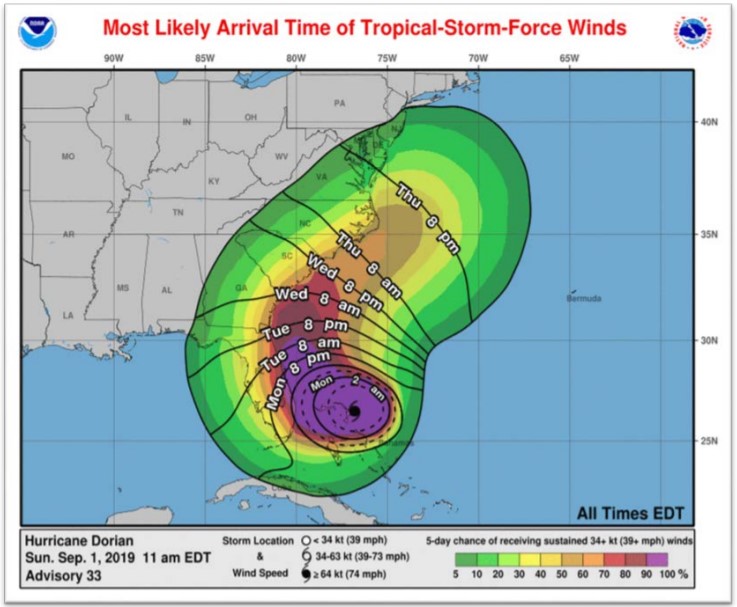Recent weeks have seen some additional drama over last Septembers hurricane dust-up between President Trump and the National Weather Service. Last week, the Commerce Departments inspector general was crying foul over leadership stonewalling the release of her report on any legal issues arising from the dustup. That report is now out, and it brings some resolution to the tale.
If youre unfamiliar with the background, as Hurricane Dorian approached the US coast, President Trump tweeted that Alabama would “most likely be hit (much) harder than anticipated”—a statement that was untrue, as the storm was set to turn north and up the Eastern Seaboard. His statement, however, prompted calls from concerned people in Alabama, who wondered if the forecast had changed. In response, the Birmingham National Weather Service office tweeted, “Alabama will NOT see any impacts from #Dorian.”
Annoyance and investigations
This tweet perturbed the White House, eventually resulting in a controversial, unsigned statement released by NOAA that essentially said the president was technically right and the Birmingham office should have qualified their tweet. (There was also an incident in which a hurricane forecast map in the Oval Office was modified with a black marker to make it look like Alabama might have been in danger.)
The NOAA statement in turn prompted formal complaints, which set off several investigations into the matter. The broad outlines of what happened have been known for a long time: the White House was upset and called Commerce Secretary Wilbur Ross, whose office worked with NOAA leadership to push out the statement. A report released last month by NOAAs Scientific Integrity officer reinforced that picture, faulting NOAA leadership for playing along but noting that Commerce staff had run the show.
The panel behind that report had no access to the Commerce staff, but Commerce Inspector General Peggy Gustafson did. And although the outline of events was known, some of the details in Gustafson's report are remarkable.
The report includes interviews with everyone involved in the statement, as well as some emails and text messages. And that allows for a step-by-step description of events—even though there are discrepancies in the versions presented by different people.
Everything started with an email from acting White House Chief of Staff Mick Mulvaney to Commerce Secretary Ross. Mulvaney explained that Trump tweeted based on the latest info they had seen and did not understand why the Birmingham office would tweet a correction. “As it currently stands,” Mulvaney wrote, “it appears as if the [National Weather Service] intentionally contradicted the president. And we need to know why. He wants either a correction or an explanation or both.”
Jobs on the line
Ross reached out to acting NOAA Director Neil Jacobs to ask what the timeline of forecasts was to see where the two tweets fit in. The next day, he tasked his Chief of Staff Michael Walsh and acting Deputy General Counsel David Dewhirst with following up on the information gathering, which turned into statement writing with NOAAs Neil Jacobs and his director of communications, Julie Kay Roberts.
Roberts said that Walsh told her that “there are jobs on the line. It could be the forecast office in Birmingham. Or it could be someone higher than that. And the higher is less palatable.”
These four gave different accounts of the meeting in which the statement was drafted. Dewhirst claims he was more or less just typing up the statement but that the NOAA folks were dictating it. Everyone else seems to indicate that it was Dewhirst who was responsible for the contents of the statement.
NOAAs Jacobs and Roberts went through the timeline of forecasts, finding that significant effects in Alabama had dropped out by the Saturday morning forecast—long before Trumps tweet late Sunday morning. The National Security Council was receiving updated forecasts in real time, meaning the president should have been briefed of this already. Jacobs had explained that “AL was never in the track cone… AL was in the percent probability of seeing tropical storm force winds” and that “[n]obody here would have said that AL was going to have impacts with a 15 percent chance of seeing 39 mph winds. Thats just a windy day, even if it was 100 percent chance.”

But that ended up being exactly the justification used to defend Trumps tweet that Alabama would “most likely be hit (much) harder than anticipated”—a forecast map showing a sliver of Alabama with a chance of winds over 39 miles per hour. The latter half of the statement was the most controversial:
The Birmingham National Weather Services Sunday morning tweet spoke in absolute terms that were inconsistent with probabilities from the best forecast products available at the time.
NOAA leadership apparently pushed back on this move, with Jacobs calling it “just a bad idea.” But Commerce staff overruRead More – Source
[contf] [contfnew] 
arstechnica
[contfnewc] [contfnewc]







